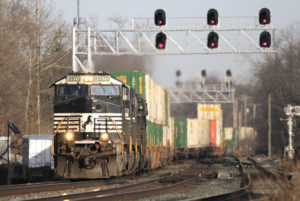
TRAINS: David Lassen
NORFOLK, Va. — With intermodal and some merchandise volume turning positive in the fourth quarter, Norfolk Southern expects continued traffic growth this year as the economy recovers from the pandemic.
NS expects revenue growth of about 9% this year, led by high single-digit growth in intermodal and merchandise volume excluding energy-related traffic. Coal volume will continue to decline due to low natural gas prices, increased use of renewable energy, and unusually high utility stockpiles, executives said on the company’s earnings call Wednesday.
“As we take stock of what we achieved in 2020 while managing both the pandemic and energy market challenges, including the successful idling of four additional hump operations while driving productivity to record levels, we see much more opportunity ahead,” CEO Jim Squires said in announcing earnings.
Fourth quarter volume declined 1% overall. Intermodal volume was up 5%, merchandise declined 5%, and coal sank 25%.
Domestic intermodal grew 7% in the quarter, propelled by a 30% increase in premium business that includes e-commerce shipments, Chief Marketing Officer Alan Shaw says. Demand is expected to remain strong this year due to consumer spending and retailers restocking depleted inventories.
The merchandise decline was driven by a drop in crude oil, natural gas liquids, and frac sand shipments, which were off due to the impact of the pandemic, lower refinery production, additional pipeline capacity, and reduced oil and gas drilling.
Other merchandise segments were on their way to recovery, Shaw says, including steel, automotive, plastics, forest products, and agricultural shipments. NS expects a manufacturing and housing rebound to lead to merchandise volume growth this year.
For the quarter, the railroad’s operating income increased 2%, to $984 million, even though revenue declined 4%, to $2.5 billion. Earnings per share grew 4%, to $2.64. The operating ratio improved 2.4 points to a record 61.8% thanks in part to an 8% decline in expenses as the railroad moved its tonnage on fewer but longer trains.
For the year, operating income and revenue tumbled 13% as the pandemic and a collapse in energy commodity prices sent traffic down 12%. Some 70% of the revenue decline came from energy-related traffic including coal, crude oil, ethanol, natural gas liquids, and frac sand. Earnings per share fell 10%, to $9.25.
The 2020 operating ratio set a record by falling 0.3 points to 64.4%, the fifth straight year of improvement. “We see ample opportunity to affect more positive change and remain focused on closing the operating ratio gap with the industry,” Squires says.
NS is targeting a 3-point improvement in its operating ratio this year, with the key efficiency metric falling to 60% by the fourth quarter.
The railroad announced a $1.6 billion capital budget, up slightly from last year’s $1.5 billion.













